DIY Swirl Filter for Aquaponics
A swirl filter or solids filter is occasionally used in aquaponics to remove particles of fine fish waste. Suspended matter in the form of fish poop, floating debris, food particles are removed to clarify the water that flows back to the fish tank. Improved clarity of water aids fish health.
It also stops clogging the plant roots in a floating raft (DWC) aquaponics system and aids in the ability of the plants to absorb oxygen and dissolved nutrients.
In a conventional aquaponics system, your growbeds are in a way – your swirl filter. So extra filtration usually isn’t required. Most growbeds do a very good job in reducing the amount of impurities in the water that eventually cycle back in a recirculated aquaculture system.
Compost worms in the grow bed further help mineralise that fish waste and reduce the load that a basic system can handle.
But sometimes – depending on fish stocking densities and on what species of fish is used in an aquaponics system – a swirl filter is a good idea to reduce the amount of solids in circulation.
If you find your water getting cloudy on a regular basis and the fish hard to see in a hazy murk – then maybe adding an extra growbed – or an additional solids filter might be the way to go.
DIY Swirl Filter
There are many commercial models in production that can cost hundreds of dollars. For those on a budget making your own swirl filter from a plastic drum and a cheap plastic laundry basket might be a better alternative and save you a ton of cash! A Do-It-Yourself Swirl Filter may not look very flash – but if it does the job keeping your fish water clean – then who cares!
One person who has studied swirl filters and how to use them effectively is Australian school teacher and Aquaponics enthusiast Dave or “Daveoponics” as he likes to refer to himself on forums.
Dave raises Barramundi and Tilapia in Brunei in a tropical climate.
Barramundi or Sea Bass fingerlings as they are known over there are a lot cheaper to buy than in Australia and a natural way to secure clean organic fish for Dave to feed his family as well as growing the kinds of vegetables that are not easily found in the local Asian market.
If you read my recent post on barramundi you would know that these fish are notorious for pooping a great deal and when you overstock your system with too many fish – you need to find a solution to keep the water sparkling clean.
Building your Own Swirl Filter
Dave built his own swirl filter from a 200 litre blue barrel and a plastic laundry basket. Notice the construction of his spray pipes and the elbows that can be adjusted to direct the water flow in a centrifugal force or “swirl” pattern.
Solids are swirled to the sides and deposited at the base of the blue barrel before the cleaner water makes its way to the grow bed eliminating the heavier solids.
The laundry basket made a neat fit into his DIY blue barrel. He then found a sheet of thick foam and lined it around the inner wall of the laundry basket. At the base of his basket he used some natural coral for additional filtration,
His system works very well and traps all the fish waste that his 100 barramundi produce. Cleaning the Swirl Filter is pretty simple. He can drain off the sludge by adding a small tap at the base of his barrel. The whole thing can be easily hosed out with a pressure hose as well.
Dave explains how his system works, “I made the drain dead centre in the bottom of the barrel. It is a bit more effective in removing all the muck but not critical.
I divert the waste pipe into my Papaya patch and everything in the dirt there is thriving. It feeds Paw paws, passionfruit, parsley, okra and indirectly the squirrrels who seem to think I’m growing all this stuff for their family.” he said.
“I drilled the bottom of basket with holes, lined edges with aquarium foam, in the middle is a laundry bad full of coral. You could go to town and fill the whole basket with light medium I suppose, but I have found the foam and coral work well. On the other filter I have filled the basket with some of those aquarium filter “toilet brushes”. It works even better. The whole unit is really easy to clean. I just hose it out every few weeks.” he said.
“It is easy to make.” he says, “I’m sure there are better filters (out there) but as a DIY one this is simple and works.”
Dave has two swirl filters on his other systems. Both filters sit about 1 metre off the ground on heavy duty hardwood stands. The water is pumped from the center of the Fish Tank and gravity feeds down to the top of the barrel swirl filters and then on to the Grow Beds.
“The one improvement I would suggest to the design is to put a conical base in the drums to help drain the solids.” said Dave, “When I clean the filters I just hose them out so they are low maintenance.”
Commercial Swirl Filters are further discussed and demonstrated in the Aquaponics Secrets DVD that we produce.
Update: Dave has alerted us to an error in the graphic of his DIY Swirl filter illustrated above. The Water Flow inlet pipe into the blue barrel should be at a lower level than the outlet pipe. The graphic has been fixed.
“Just one small error is that in the diagram of the barrel where you show the water outlet at the bottom of the drum going to the growbeds. In my filters, the water outlet is at the top. The water from the fish tank is pumped into the drum about one third of the way from the bottom of the drum.” said Dave, “Most solids then drop and settle at the bottom of the drum. Lighter suspended solids are trapped by the filter foam in the basket at the top third of the barrel. Clean, clear water passes through inside the basket and foam. Some biofilm also forms here as there is very little water movement. A 40mm ball valve is opened a few times a week or more often depending on fish density.”

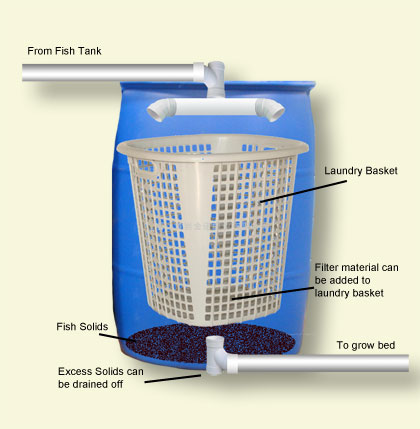





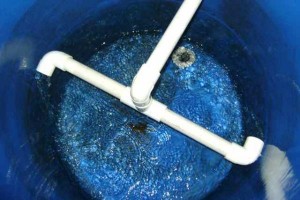
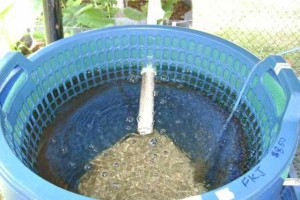
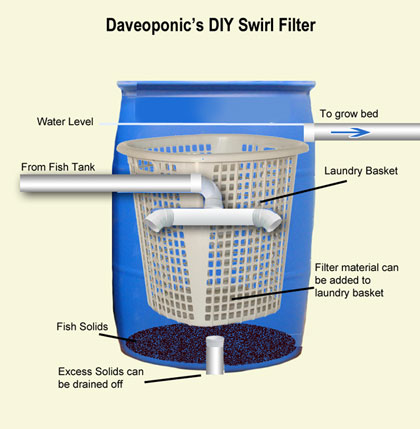
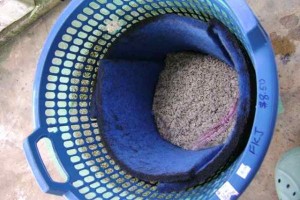
This Article is so good, I had to include it in
My Digest. Keep up the good work.
http://aquaponics-digest.blogspot.com/
Regards
Bruce
I like this idea instead of a sump tank. looks easier to clean also.
This is awesome, I included it in my blog at http://www.greenjesster.org
Thanks for posting!
hi I am building a filter and like this one so i will be makeing it over the next week, on the botton for the waste you could fit the pipe to remove solids and were the garden is if you make holes in it will deposit on the garden